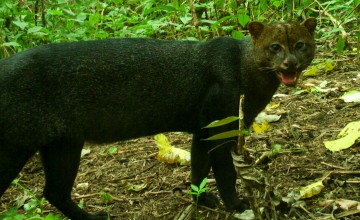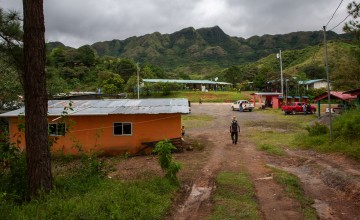
Jefferson
Hall
The more we learn about tropical reforestation the more we realize how beneficial it is to a diverse set of ecosystem services that we have come to depend upon and take for granted.
Research Focus
My research interests span a broad range of subjects from conservation biology and restoration ecology to collaborations with social scientist and economists on subjects related to human behavior and land management. The common theme is the applied nature of my work and the effort to provide information in a form that is useful to policymakers and practitioners.
The Agua Salud Project that I direct includes a 700-hectare landscape-scale laboratory where we quantify goods and services provided by a seasonal tropical forest and how they change with land use. Through a series of core monitoring networks and controlled manipulations we strive to understand the role of biodiversity in regulating stream flow, sequestering carbon, and other ecosystem processes with the goal of developing the next generation of models that will allow us to make projections in a future dominated by global change.
Additional links
Contact
Research Overview
How can degraded landscapes be restored to productivity?
Not all lands can be protected and conserved as national parks. However, both rural land owners and city dwellers derive benefits from the land. Too often though, lands are not managed for long-term productivity, be it the more classical ecological definition of productivity as it relates to vegetation growth and carbon cycling, or producing water-related or other ecosystem services. For a rural land owner, productivity might mean profitability. We study different passive and active reforestation interventions that will help restore forests on nutrient-poor soils to meet different stakeholders’ definition of productivity, including the trade-offs inherent to managing for one objective over another.
What is Smart Reforestation®?
At the broad scale, we study how forests and other land uses produce ecosystem services. Smart Reforestation takes advantage of this knowledge to promote better land use planning across landscapes and watersheds such that priority areas of ecosystem service production are managed for the efficient delivery of these services to the people who depend upon them. At a more localized scale, Smart Reforestation entails informed species selection for reforestation in a way that optimizes the management objective.
Is the forest a sponge?
The sponge effect relates to the forest’s ability to regulate stream flow, be it enhancing dry season flow or mitigating peak flooding. The Agua Salud Project has found evidence for a sponge effect, with dramatic consequences during extreme weather events.
How will global change affect ecosystem services provided by forests?
One prediction of global change for which there is little dispute is that we will experience more frequent, extreme weather events. Be it entirely coincidental or linked to global change, we have experienced the three biggest storms in the last 50 years in the Panama Canal Watershed in just six years. During the El Niño of 2015-2016 we experienced one of the driest years ever recorded. In the Agua Salud Project we are able to take advantage of both extreme weather events and land use change to look into a future of global change. Our research suggests that forests will play a key role in mitigating and adapting to global change.
What is the optimal mosaic of land uses in tropical watersheds?
The optimal mosaic of land uses is one that takes into consideration the diverse needs of stakeholders to optimize the production and delivery of ecosystem services. It should not simply take into consideration short-term economic gain but rather balance resilience to extreme weather events and ensure the conservation of biodiversity.
Education
Yale University, School of Forestry & Environmental Studies
Ph.D. in Tropical Forest Ecology / Silviculture, 2002. Advisor: P. Mark S. Ashton
Yale University, School of Forestry & Environmental Studies.
M.F.S. in Tropical Forest Science, 1992. Advisor: Florencia Montagnini
Miami University
B.A. in Zoology with Minor in French, 1983
Selected Publications
Hall, J.S., Ashton, M.A. 2016. Guide to Survival and Early Growth in Plantations of 64 Native Tree Species to Panama and the Neotropics. 160 pp. ISBN 978-9962-614-37-1.
Hall, J.S., Kirn, V., Yanguas-Fernandez (Eds.). 2015. Managing Watersheds for Ecosystem Services in the Steepland Neotropics. Inter-American Development Bank Monograph, 340. 186 pp. https://publications.iadb.org/handle/11319/7233.
Plumptre, A.J., Nixon, S., Kujirakwinja, D., Vieilledent, G., Critchlow, R. Nishuli, R., Kirkby, A., Williamson, E.A., Hall, J.S. 2016. Catastrophic decline of world's largest primate: with 80% loss, Grauer's Gorilla (Gorilla beringei graueri) population is critically endangered. PLOS ONE: DOI:10.1371/journal.pone.0162697.
Battermann, S.A., Hedin, L.O., van Breugel, M., Ransijn, J., Craven, D., Hall, J.S. 2013. Tropical carbon sink depends upon N2 fixation and biodiversity. Nature 502:224-227.
Ogden, F.L., Crouch, T.D., Stallard, R.F., Hall, J.S. 2013. Effect of land cover and use on dry-season river runoff, runoff efficiency and peak storm runoff in the seasonal tropics of Central Panama. Water Resources Research
Van Breugel, M., Hall J.S., Craven, D., Bailon, M., Hernandez, A., Abbene, M., van Breugel, P. 2013. Succession of ephemeral secondary forests and their limited role for the conservation of floristic diversity in a human-modified tropical landscape. PLOS ONE: e82433.
Breugel, M. van, Hall, J.S., Craven, D.J., Gregoire, T.G., Park, A., Dent, D.H., Wishnie, M.H., Mariscal, E., Deago, J., Ibarra, D., Cedeno, N., and M.S. Ashton. 2011. Early growth and survival of 49 tropical tree species across differing soil fertility and rainfall gradients in Panama. Forest Ecology and Management 261, 1580-1589.
Hall, J.S., Ashton, M.S., Garen, E.J., Jose, S. 2011. The ecology and ecosystem services of native trees: Implications for reforestation and land restoration in Mesoamerica. Forest Ecology and Management 261, 1553-1557.
Hall, J.S., Harris, D.J., Medjibe, V., and Ashton, P.M.S. 2003. Effects of selective logging on forest structure and tree species composition in a Central African forest: implications for management of conservation areas. Forest Ecology and Management 183, 249-264.
Hall, J.S., White, L.J.T., Inogwabini, B.I., Omari, I., Morland, H.S., Williamson, E.A., Walsh, P., Saltonstall, K., Sikubwabo, C., Bonny, D., Kaleme, K.P., Vedder, A., and Freeman, K. 1998. A survey of Grauer's gorillas (Gorilla gorilla graueri) and chimpanzees (Pan troglodytes schweinfurthii) in the extension of Kahuzi-Biega National Park and adjacent forest in eastern Congo. International Journal of Primatology 19, 207-235.


